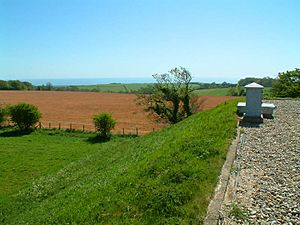Folkestone to Etchinghill Escarpment facts for kids
| Site of Special Scientific Interest | |
 |
|
| Area of Search | Kent |
|---|---|
| Interest | Biological Geological |
| Area | 263.2 hectares (650 acres) |
| Notification | 1985 |
| Location map | Magic Map |
The Folkestone to Etchinghill Escarpment is a special natural area in Kent, England. It covers about 263.2 hectares (650 acres) near Folkestone. This site is important for both its amazing plants and animals, and its interesting geology.
It is officially known as a Site of Special Scientific Interest (SSSI). This means it's a protected area because of its rare wildlife or unique landforms. It's also a Special Area of Conservation, which is an even higher level of protection across Europe.
Why is this Place Special?
This area is home to many different habitats. A large part of it, about 205 hectares (510 acres), is a special type of grassland. This grassland is listed as a Grade 2 site for nature conservation. It means it's very important for its natural features.
Another important part is Asholt Wood, covering about 70 hectares (170 acres). This woodland is considered a Grade 1 site. This shows how valuable it is for its trees and the creatures living there.
Amazing Plants and Lichens
The chalk grassland here is very unique. It has three types of plants that are super rare across the whole country. This makes the escarpment a vital place for protecting these species.
Asholt Wood is also special for its lichens. Lichens are like a mix of fungi and algae that grow on trees and rocks. The lichens in Asholt Wood are outstanding, meaning there's a huge variety of them.
A Look into Earth's Past
The Folkestone to Etchinghill Escarpment is also important for geology. It includes a place called Holywell Coombe. This area is a key site for understanding Earth's history.
At Holywell Coombe, scientists can find many mollusc fossils. These are the remains of creatures like snails and clams. By studying these fossils, experts can learn about how the environment changed over long periods. The fossils show what life was like during the late Pleistocene and Holocene periods. These are two very long periods in Earth's history, covering thousands of years.

